The next-gen MacBook Pro with Retina Display Review
by Anand Lal Shimpi on June 23, 2012 4:14 AM EST- Posted in
- Mac
- Apple
- MacBook Pro
- Laptops
- Notebooks
The King of All Notebook Displays
For years Apple has been shipping some of the best displays in consumer notebooks, but the MacBook Pro’s Retina Display is in a league of its own. While I never liked the phrase “painted on” in reference to the iPad and iPhone Retina Displays, that’s the best way I can describe the effect the MacBook Pro’s Retina Display has on me. Text really does look painted on. The effect is really the result of two things.
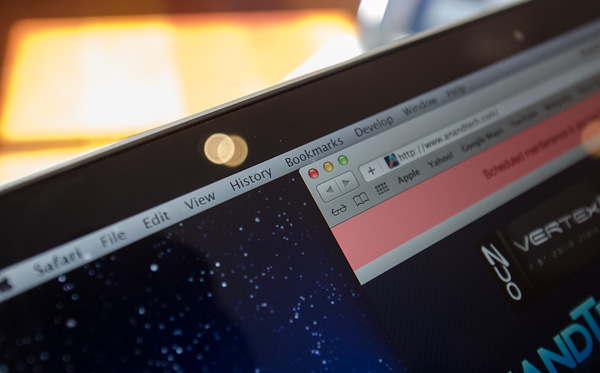
The first is Apple’s removal of its cover glass. LCD panels aren’t particularly attractive, they are ugly squares composed of two pieces of glass and a number of filters/polarizers. To hide the ugly edges, display makers wrap bezels around the display. Most people aren’t fond of bezels so next came a ton of effort to minimize bezel size. An alternative is to simply place a third piece of glass over the entire LCD assembly and make it look as if the bezel and LCD panel are integrated. This outermost layer is known as a cover glass and is what Apple uses on all of its glossy displays. If you’ve ever taken apart a Cinema/Thunderbolt Display or a newer iMac you’ll know that the cover glass is literally just a piece of glass that you have to remove with some suction cups.
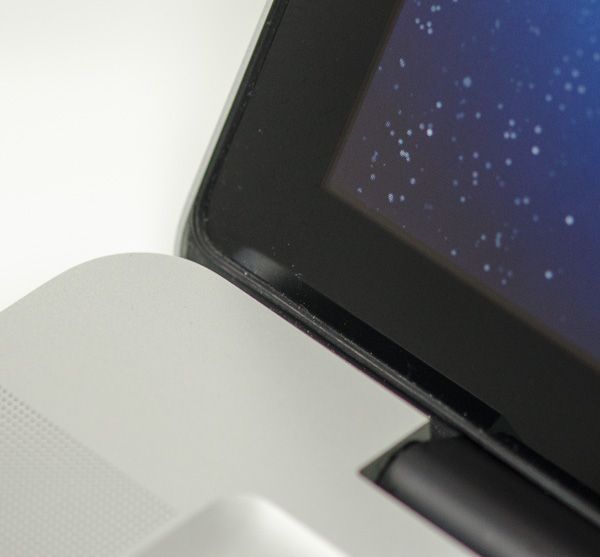
Non-Retina MacBook Pro, notice the gap between the outermost LCD glass and the cover glass
The MacBook Pro’s Retina Display does away with the cover glass and instead uses a fairly unique LCD assembly. There are still two pieces of glass but the outermost glass is actually a different size and shape - it integrates a bezel. By integrating the bezel into the outermost glass in the LCD stack you get the same effect as a cover glass but without the added reflections it introduces.
You also limit the possibility of dust getting trapped between the cover glass and the LCD. The danger is that you no longer have a protective piece of glass in front of your expensive new LCD. If you scratch the display you're scratching the LCD itself. While this has been true for conventional matte displays for a while, it's worth mentioning if you're used to Apple's glossy displays where you did have that added security layer.
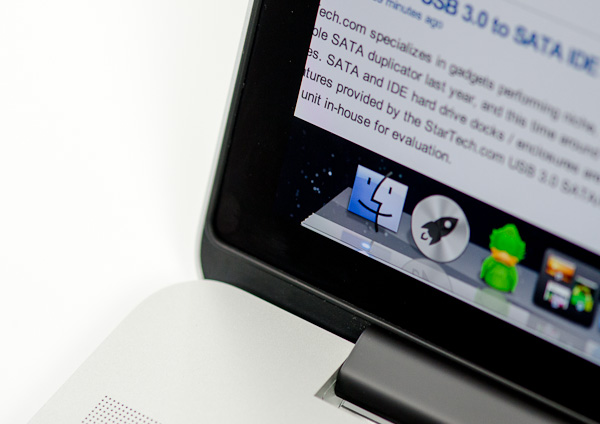
The MacBook Pro with Retina Display, no gap, no cover glass
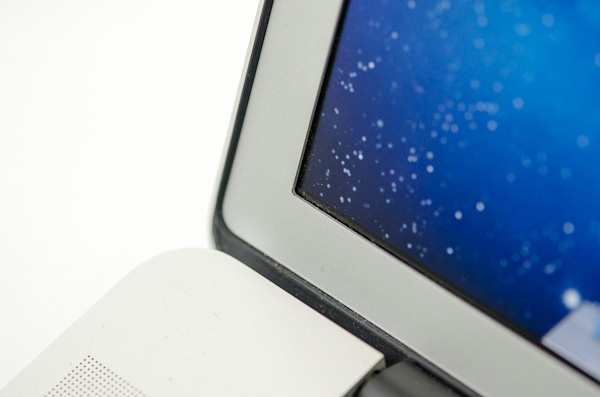
The 2011 MacBook Pro with High-Res Matte display option, no cover glass, top bezel

From left to right: 2010 High Res Glossy MBP, 2012 rMBP, 2011 High Res Matte MBP
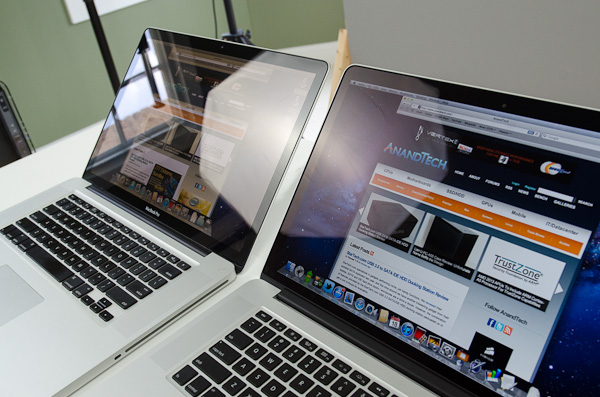
Glare handling indoors - 2011 High Res, Glossy MBP (left) vs 2012 rMBP (right)
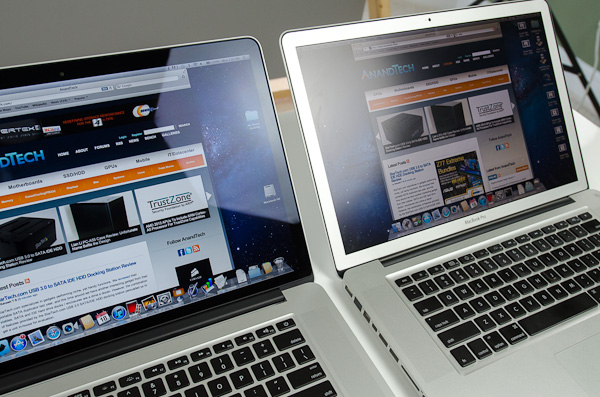
Glare handling indoors - 2012 rMBP (left) vs. 2011 High Res, Matte MBP (right)
The Retina Display is also obviously an extremely high resolution panel at 2880 x 1800. Note that this is 44.6% more pixels than Apple’s 27-inch Thunderbolt Display, and 26.6% more pixels than the 30-inch panels that we’ve loved for so long - all in a 15.4-inch notebook display.
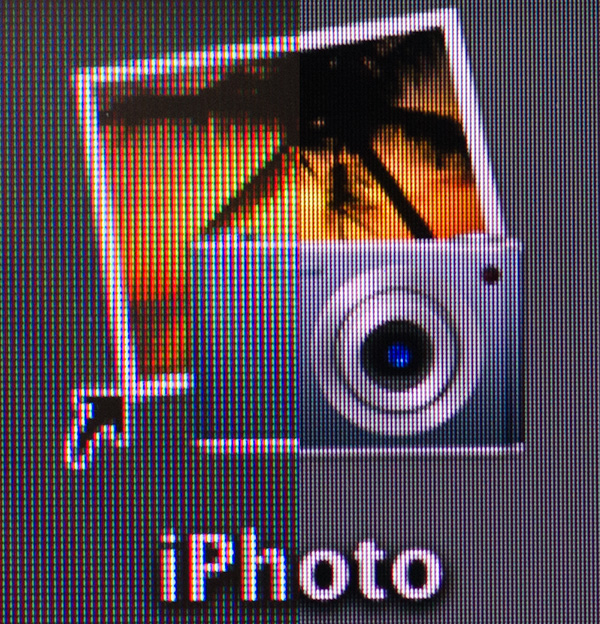
An iPhoto shortcut, High Res 2011 MBP (left) vs. Retina Display MBP (right)
At 220 pixels per inch it’s easily the highest density consumer notebook panel shipping today. At normal viewing distances and even with my face closer than I’m comfortable putting it I simply cannot discern individual pixels.
It’s the combination of these two elements, the removal of the cover glass and the insanely high pixel density that makes everything from text to UI elements just look painted on the new Retina Display. And the effect is gorgeous. I’ve never seen a prettier panel and it’s actually ruined me for pretty much all other displays, notebook and desktop.
While I can appreciate the iPad’s Retina Display, the impact from the MacBook Pro’s display is even more significant. Perhaps it’s because I still spend so much time working on a standard, non-tablet display, but I’m far more excited about this display than anything else Apple has delivered under the Retina moniker.
It’s not just pixel density that Apple has to offer here. Similar to its Retina Displays in the iPhone and iPad, the MacBook Pro’s Retina panel ditches TN in favor of IPS technology. The result is an incredible improvement in viewing angles. On a notebook I don’t spend a lot of time viewing it from far left/right angles, although I see the benefit when I’ve got others huddled around my display. Here the panel performs admirably - you lose brightness at far left/right angles but there’s no perceivable color shift. In fact, the painted on effect is even more impressive at these far left/right viewing angles.
For a single user however the more impressive characteristic is just how good the display looks at vertically off-center angles. I wrote much of the initial parts of this review while on an airplane in coach, which with a 15-inch notebook on my lap means I’m going to be looking at the display at a weird angle to begin with. The thinner rMBP doesn’t do enough to make the airplane usage model any better if the person in front of you decides to recline, but the IPS panel does make the display perfectly usable at the off-center angle you’ll inevitably have to deal with.
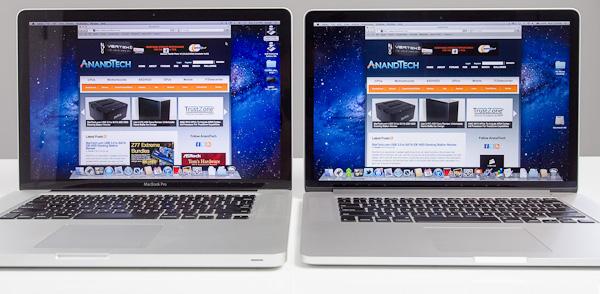
2010 High Res, Glossy MBP (left) vs. 2012 rMBP (right)
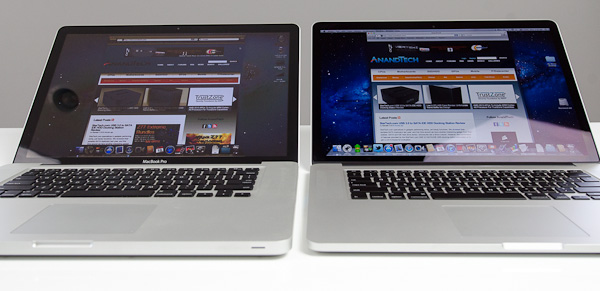
Hello colorshift!
2010 High Res, Glossy MBP (left) vs. 2012 rMBP (right)


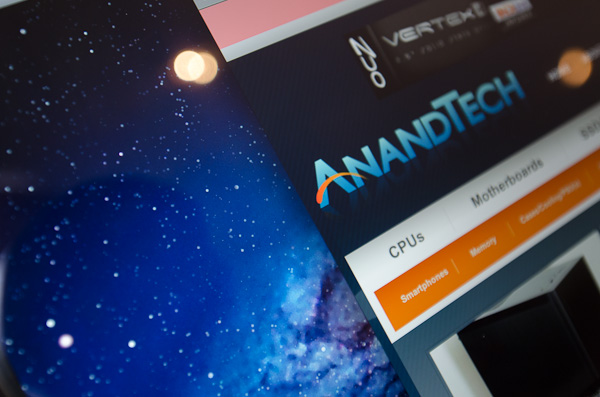
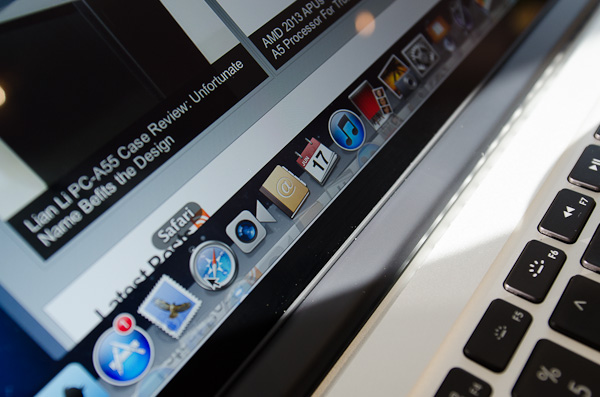
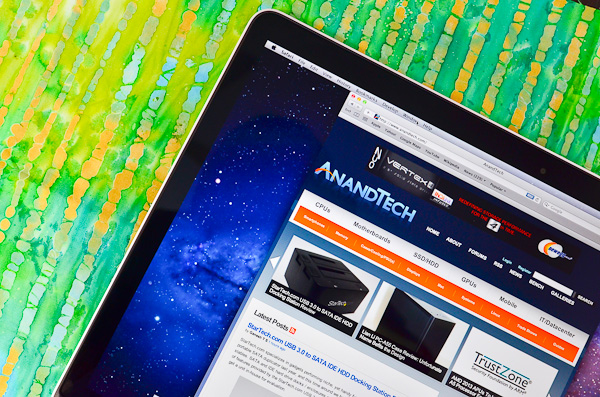
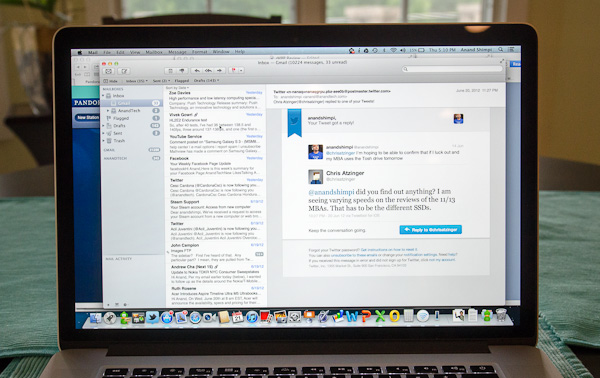
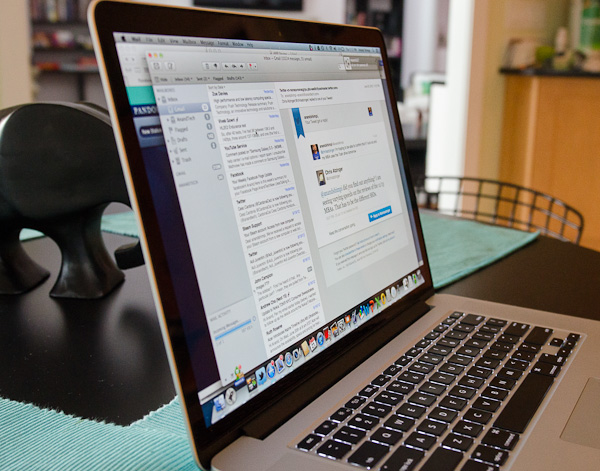








471 Comments
View All Comments
spronkey - Sunday, June 24, 2012 - link
I don't know why people quote this. Who is this "Most People"? The MBP isn't targeted or priced for "Most People".In my personal experience, by far and away the majority of people who own computers end up upgrading *something*, or replacing something out of warranty.
Though, in the lattery category the most common would be replacing a dead HDD, but I don't buy the most people don't upgrade argument. Just look at how large otherworldcomputing is now; and companies like Corsair, Crucial, Kingston wouldn't be producing specific parts for Apple machines if there wasn't a massive upgrade market.
tim851 - Sunday, June 24, 2012 - link
I don't think RAM increases have sped up at all.My major builds over the years:
'96: 8 megs
'98: 16 megs (upgrade)
'99: 128 megs
'01: 512 megs
'03: 1 gig
'06: 2 gig
'08: 4 gig
'12: 8 gig
I don't think most people, including the creative prosumers Apple is targeting, are seeing much use of >4 gigs. 8+ gig configurations have become fairly commonplace recently because RAM has just been ridiculously cheap. I only got the second 4 gig this year because it's been like 30 Euro. Haven't really noticed any of it.
SSDs have taken the pain out of disk swapping too.
Yes, you can cite a lot of anecdotes of people with their multiple virtual machines and huge 4k video projects, but then again Apple has never been trying to satisfy 100% of the market with any product.
felixneo - Sunday, June 24, 2012 - link
maybe not everyone need 8+ GB ram but, for example Adobe Illustrator CS6 recommends 8GB ram on the system requirements page, so i don't know if that qualify as an anecdote, but it sure is the target market for such a laptop. If you don't need more than 4GB ram why you buy a Pro and not an Air? a pissing contest?dtolios - Sunday, June 24, 2012 - link
Its a pissing contest for the VAST (VAST) majority of the MBP buyers, ofc.Vanity is what drives (revenue wise) most high end stuff in Computers, and that is exactly what Apple is about, and made it BIG once they realized who to capitalize on it instead of creativity etc.
Let the romantics and the Jobs is a Saint believers say otherwise.
It's the same in the sports car market (oh, wait, i though all ppl driving around in expensive superfast cars were racing drivers), smartphones (even before the iPhone, but especially after it), the large screen TV, and the clothing industry. It's all a pissing contest, and lucky the few who actually get to distill the innovations to make more innovations out of, thanks to the above contestants paying for things to move forward, even if companies side-step a lot in order to maximize their profits (and not please the crowd, NEVER forget that).
EnerJi - Sunday, June 24, 2012 - link
Screen size, for one. There is no 15" MacBook Air. I'm sure it would sell well if it existed.dagamer34 - Sunday, June 24, 2012 - link
This IS the 15" MacBook Air for all intents and purposes. In fact, that's why I'm almost certain they didn't label the display with the "MacBook Pro" logo. When the other laptops in the lineup get Retina displays, Apple will only be selling "MacBooks". I also expect for the taper to disappear in what we currently call Airs because of the increased battery size needed for the Retina Display. There will also only be one 13" laptop.spronkey - Sunday, June 24, 2012 - link
Actually you just proved my point. In terms of megabytes per year, the trend is close to an exponential increase!Remember - going from 4GB to 8GB is adding more ram in the space of 4 years than you've *ever had in total before*.
We're also starting to see operating systems utilise this more through:
- Caching and prefetch
- Virtualisation
aaand let's not forget what's happening in the browser space - websites are now minature applications with their own requirements on memory.
I'm a software engineer who moonlights as a graphic designer - 4GB isn't enough at all for decent design work - Until I upgraded from 4GB to 8GB early last year, I would often find InDesign and Photoshop eating up all my available memory between them, and 8GB is starting to feel pretty limiting if you want to do a few things with your machine - especially when you start hooking up multiple external displays.
SSDs may take some of the pain out, but things are only going to get worse.
wfolta - Sunday, June 24, 2012 - link
I always use Moore's Law in my plans: a doubling in 18 months. Yes, that's exponential, but when you look at it in terms of "doubling", it's not as crazy as you want to make it out to be.The MBP 17" I was using up until last week had 4GB and that was barely adequate. My rMPB's 16 GB is two doublings, which comes out to 36 months -- 3 years. So in about 3 years, I'll be feeling that 16GB is barely adequate.... except with an SSD I'll actually be a bit better off.
The posting by tim851 shows an increase that's considerably less than doubling every 18 months, which would mean 16 GB would last him even longer than 3 years.
It's a tradeoff: do you want a laptop that's small and light enough to meet Intel's Ultrabook definition, yet it has a screen no laptop can match at any price, a dedicated graphics controller, great battery life, and incredible build quality, with enough RAM that you don't have to worry about upgrading for 3 years or more? Then nothing touches the rMBP.
If you want to trade off several cool feature and slip into the cheapest model machine you can afford, planning on upgrading its components every year or so to keep it acceptable? Then the rMBP's overpriced and inflexible. For you.
spronkey - Monday, June 25, 2012 - link
The point I'm trying to make is that it didn't *have* to be a trade-off. They could have engineered two SODIMM slots in that thing, and a standardised mSATA card. Especially given how much better thermally it is than the previous model...SPLENDEUR - Sunday, June 24, 2012 - link
This was the review I was looking - and waiting - for. It is great that this review goes past the bling factor of the new MBP and goes into the longitudinal nitty gritty.The section regarding Safari performance in this higher resolution, how it jitters during scrolling, was of welcome notice - it has given me a second opinion I needed on whether I should readily buy this (the Retina-populated reviews almost had me!)